The grey wolf holds a special but complicated place in the human imagination. They simultaneously inspire fear, awe, fascination, and even a degree of spirituality and mysticism.
People have lived in an uneasy state with them for thousands of years; because of extensive habitat loss and human hunting (most often in retaliation for killing livestock or sometimes for their fur), their numbers have dwindled greatly over time.
They are now only found in the most isolated pockets of North America where humans are generally quite sparse. It is estimated that less than 100,000 wolves remain across the entire continent, most of which can be found in northern Canada and Alaska.
Canine classification is a difficult and fraught subject, prone to much-heated debate. Traditionally, there has only been a single wolf species: the grey wolf. Any unique variation or distinct population was assumed to be a subspecies of the grey wolf.
There are many factors that determined whether a population warrants the subspecies classification. Variations in size, color, and skull morphology are all considered. Most importantly, though, a subspecies needs to be geographically isolated. This prevents different populations from reproducing with each other, allowing them to develop and evolve independently.
At one point scientists recognized about 24 subspecies of the wolf in North America. Some of them have gone extinct, some of them are no longer recognized as distinct subspecies, and some might be separate species entirely on their own. This article will cover 10 different types of wolves in North America, helping to clarify what we know and what we don’t about how they’re classified.
Eastern Wolf
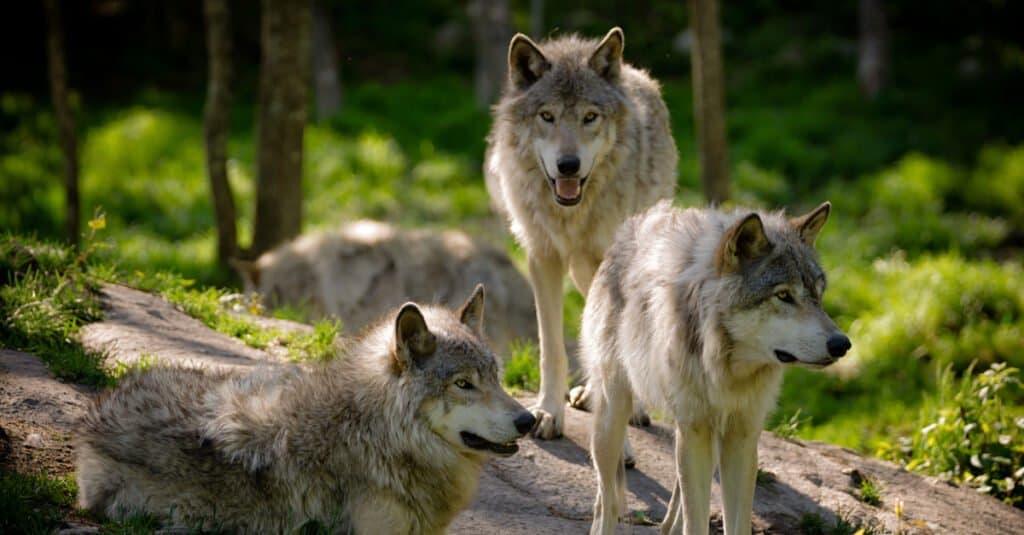
©iStock.com/GatorDawg
This lightly built wolf, featuring grizzled brown or cinnamon-colored fur, goes by many names, including the eastern wolf, the timber wolf, and the Algonquin wolf (the Algonquin are an indigenous American people). While population numbers are very slim (perhaps no more than 500 remain), they can be found in mixed forests throughout eastern Canada, New England, and the Great Lakes states.
Both the physical characteristics and genetic evidence suggests that the eastern timber wolf is actually the product of a relatively recent hybridization event between the grey wolf and the coyote. As a result, some biologists have argued that the eastern wolf is largely distinct from the grey wolf and should be considered a separate species entirely. Unfortunately, there is no real consensus about how to classify it.
Red Wolf
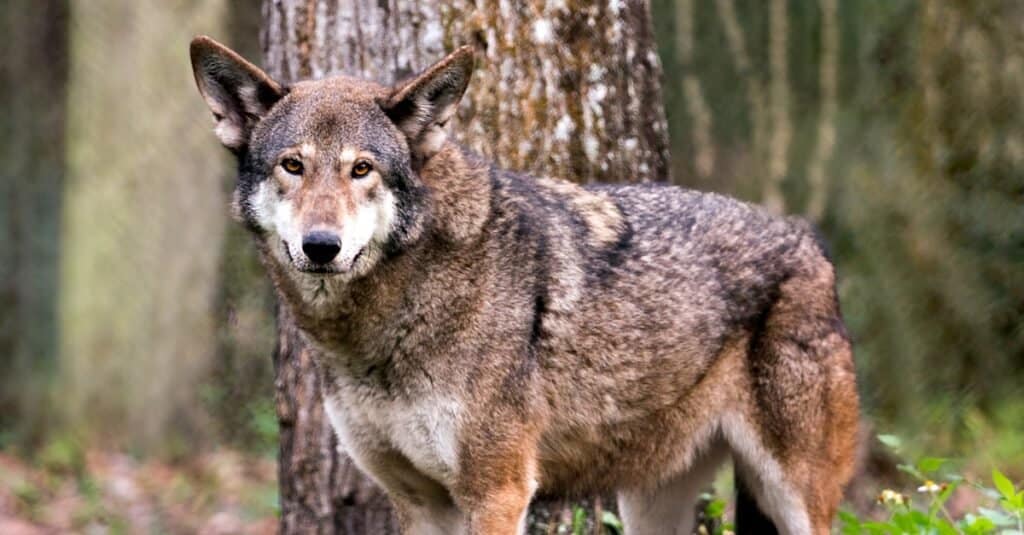
©Rejean Bedard/Shutterstock.com
A close relative of the eastern timber wolf subspecies, the red wolf was also thought to arise from a cross between the grey wolf and the coyote at some point in the past. Its historical range once encompassed most of the southeastern United States, but by the middle of the 20th century, numbers had been dramatically reduced until it was officially declared extinct in the wild. Following a successful captive breeding program in the 1980s, it was reintroduced back into its native habitat.
However, the IUCN Red List currently considers it to be a critically endangered species with perhaps about 20 to 30 mature individuals still remaining in the wild. The only wild population is currently located along the coast of North Carolina. Taxonomically, the red wolf is still in a bit of limbo. Biologists have continued to debate about whether the red wolf is its own separate species, a separate species with the eastern timber wolf, or a subspecies within the grey wolf.
You can read more about the red wolf here.
Mexican Grey Wolf

©Nagel Photography/Shutterstock.com
The smallest of all the North American subspecies, the Mexican grey wolf (also known as the lobo) was once widespread across Mexico and the southwestern United States. It was considered to be an important cultural and spiritual symbol in some pre-Columbian Mexican cultures.
A Mexican wolf can run very at around 36 to 38 miles an hour. This species of wolf has long legs and a lanky body. The way this species of wolves’ body is made, it allows this wolves to travel at high speeds. They can reach about 5 and a half feet and is considered one of the smallest, rarest wolves that is found in North America.
Although formally protected by the Endangered Species Act in the United States, it’s estimated that only about 100 individuals still remain in the wild; these are descendants of 11 captive-raised wolves released in 1998. The remaining Mexican wolves are relegated to captive breeding programs and wolf sanctuaries.
Arctic Wolf

©Jim Cumming/Shutterstock.com
Covered in luxurious all-white fur, the Arctic wolf occupies the northern fringes of the Canadian Arctic islands. It is a medium-sized wolf, strong and muscular, weighing up to 175 pounds in extreme cases, though most probably weigh closer to 125 pounds. Because of its extreme northern range, the Arctic Wolf has been spared persecution from humans. It has not learned to fear humans like its southern kin and sometimes even approaches people out of curiosity. They survive in these extreme conditions by hunting muskox, caribou, and Arctic hares. It seeks refuge from the hostile environment in caves and other natural shelters.
You can read more about the Arctic wolf here.
Great Plains Wolf
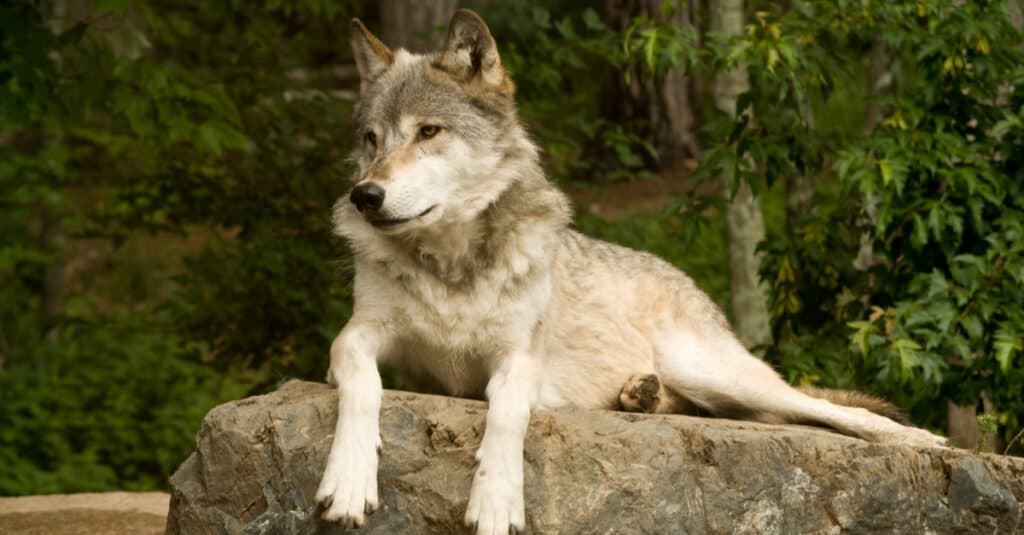
©Carol Heesen/Shutterstock.com
The Great Plains wolf was once among the most common types of wolves in North America. Its habitat range stretched across much of the central part of the continent, from Saskatchewan in the north to Texas in the south. After years of relentless hunting, however, it was declared to be officially extinct in 1926. Based on genetic analysis, some people claim that descendants still survive around the Great Lakes region, but this claim is hard to substantiate. A relatively large wolf, it could be identified by the light fur with some dark markings mixed in.
Rocky Mountain Wolf
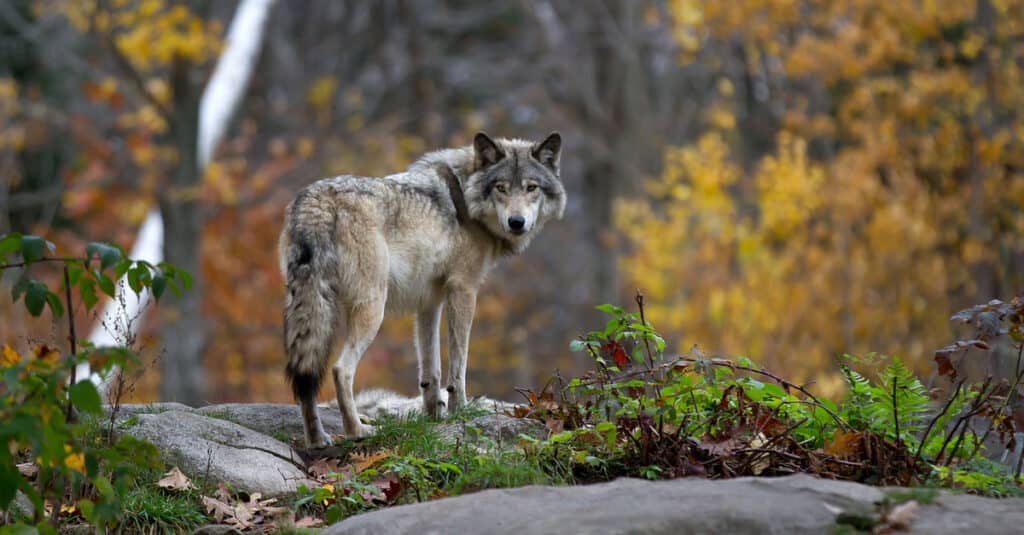
©Jim Cumming/Shutterstock.com
The Rocky Mountain wolf was historically among the most common subspecies of the west. Sporting a mixture of white and black fur, this large wolf is sometimes divided into two separate subspecies: the northern and southern Rocky Mountain wolf. Historically protected somewhat by the rugged terrain of the Rocky Mountain range, many of them were nevertheless killed in retaliation for preying upon livestock. There has been fierce debate about whether this wolf should still be afforded protection under the federal Endangered Species Act. Their population numbers appear to be stabilizing in Idaho, Montana, and Wyoming, which has led many people to argue that it no longer needs federal protection. There are currently plans to reintroduce them into parts of their former territory in Colorado.
Mackenzie Wolf

©imageBROKER.com/Shutterstock.com
The Mackenzie wolf is one of the most common types of wolves in North America. It goes by many different names, including the northwestern wolf, the Alaskan timber wolf, and the Canadian timber wolf. As the number of names suggests, the Mackenzie wolf has a very large home range stretching between Alaska, the Mackenzie River Valley in northwestern Canada, and down through Alberta and British Columbia, with a few established populations in the United States. In the 1990s Canadian wolves were chosen for reintroduction into Yellowstone National Park over the other candidate populations in part because they were already venturing that far south. These are large, powerful wolves with a thick coat of white and grey fur, sometimes shading into tan or blue. When hunting in packs, they have the ability to take down much larger prey. It’s estimated that 90% of their winter prey in Yellowstone consists of elk; much of the rest is bison and deer.
You can read more about the Mackenzie Wolf here.
Coastal Wolf
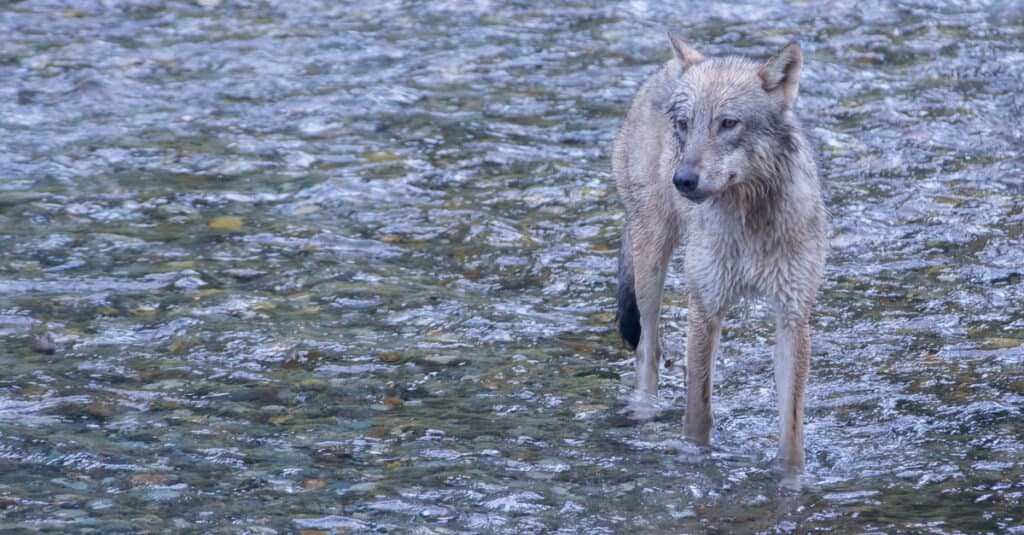
©iStock.com/Jillian Cooper
These “sea” wolves are found all along with the coastal habitats of British Columbia and Vancouver Island, feeding on salmon, marine mammals, and other seafood. They have the ability to travel between islands by swimming up to 7.5 miles at a time. Based on genetic analysis, some experts have argued that the Vancouver Island population is distinct enough to be classified as a separate subspecies.
Alexander Archipelago Wolf
Unique among many subspecies for its dark-colored coat, the Alexander Archipelago wolf is native to the coastal habitats of southeast Alaska, around the island chain that bears its name, and then down along parts of British Columbia. Conservationists have tried for decades to get the wolf classified under the Endangered Species Act. Logging, road construction, and climate-related changes represent possible population stresses. However, the US Fish and Wildlife Service argues that population numbers are currently stable and do not need additional protection.
Wolf Dog Hybrids
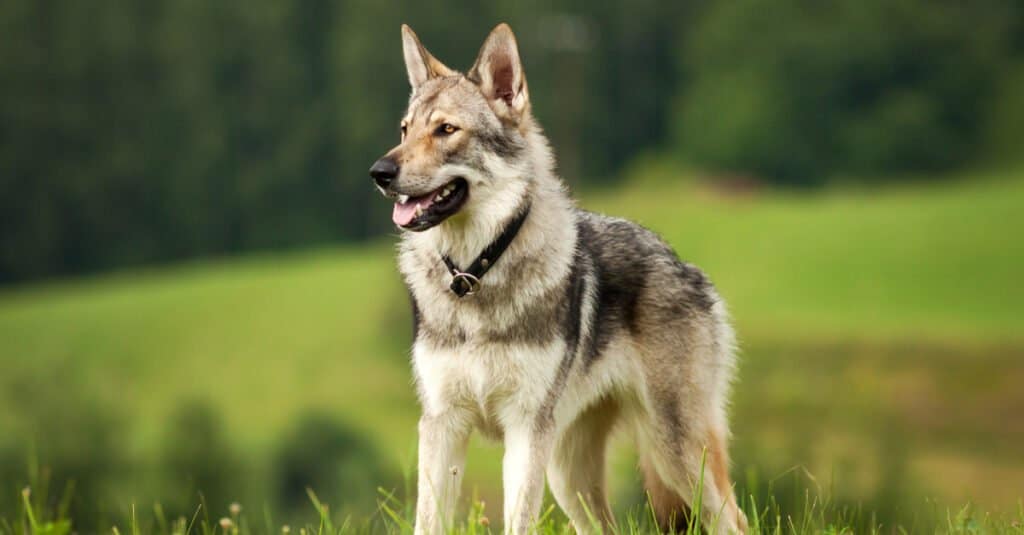
©gloverk/Shutterstock.com
Because wolves and domesticated dogs are members of the same species, they have the ability to produce viable offspring with each other. These resulting hybrid offspring often need specialized care; they’re sometimes unable to survive in the wild but are also not accepted by humans and frequently even banned in many states or countries without a special ownership permit. Many of these hybrids end up in wolf sanctuaries or conservation centers. Their physical appearance and behavior can vary quite a bit, especially depending on which dog breed it descended from. Many are territorial and difficult to control. They’re almost never recommended as pets.
List of Wolves Found in North America
Here is a list of wolves found in North America:
| Rank | Wolf Species |
|---|---|
| 10. | Eastern Wolf |
| 9. | Red Wolf |
| 8. | Mexican Grey Wolf |
| 7. | Arctic Wolf |
| 6. | Great Plains Wolf |
| 5. | Rocky Mountain Wolf |
| 4. | Mackenzie Wolf |
| 3. | Coastal Wolf |
| 2. | Alexander Archipelago Wolf |
| 1. | Wolf Dog Hybrids |
Next Up…
- Are Wolves Dangerous? – Will wolves attack you if you get too close? Keep reading to find out!
- The 10 Largest Wolves in the World – What species of wolves are the largest? Some of these sizes may surprise you!
- What Do Wolves Eat? – What’s the diet of a wolf? They like deer and rabbits, but what about color mammals? Click to learn more!
The photo featured at the top of this post is © Holly Kuchera/Shutterstock.com
Thank you for reading! Have some feedback for us? Contact the AZ Animals editorial team.







